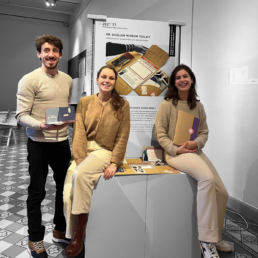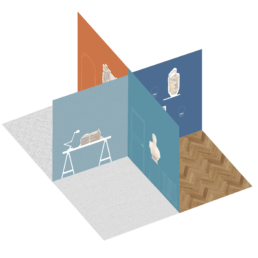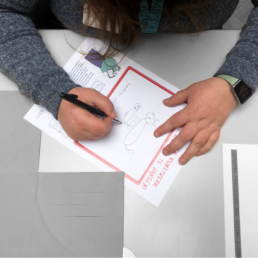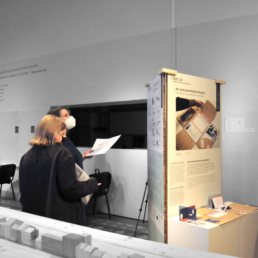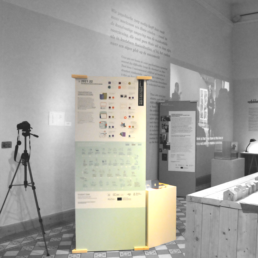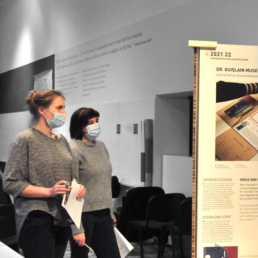This article was written by Britt Pellens, she is one of the two researchers in our design agency. As a researcher she wants to focus on inclusive design and co-creative tools. Her goal is to involve different kind of references and literature, to represent the multicultural and disciplinary class as we are.
Intro: inclusive tourism
The World Health Organisation estimates that 15% of the global population, roughly 1 billion people, live with some form of disability (World Disability Report).1
An estimated 450 million people worldwide have a mental disorder. Mental disorders account for 13% of the global burden of disease, and this figure will rise to nearly 15% by 2030.2
Within the spectrum of mental disorders there are several disabilities such as depression, bipolar disorder, schizophrenia and other psychoses, dementia, and developmental disorders including autism.3
For people with a mental disability access to health care, social services and social support is crucial. Therefore, non-medical services such as touristic and social activities or hobbies contribute to the quality of life. According to the European Disability Forum (EDF) people with a mental disability and the touristic economy itself can benefit from these services and activities. However, participating in touristic activities can still be a challenge for people with disabilities. EDF wants to raise awareness about everybody’s right to access inclusive tourism.4
MindTour project
The MindTour program is part of the Erasmus+ project about Mindful Tourism Services for Mentally Disordered People. MindTour is an international research project that aims to create accessible tourism and leisure services for people with mental disorders by using service design. The project is carried out by the Thomas More University together with the University of Latvia and the Tartu University of Estonia.5
In this project, students Space and Service design at Thomas More design services that make tourist organisations (with a focus on museums) more accessible for people with intellectual disabilities.6
For this project the students worked closely together with the partnering Dr. Guislain Museum in Ghent.7
Dr. Guislain museum as a test case
The Dr. Guislain Museum joined the MindTour project as a partnering enterprise for cultural tourism.
The museum was founded in 1986 when the former psychiatric center was transformed into a museum on the history of psychiatry. The most important reason for the foundation of the museum was the lack of access to information and knowledge about mental health care and psychiatry. The goal of the museum is to prove that the concepts of ‘madness’ or ‘psychiatric disorder’ are not purely medical, but that there is always a sociocultural and ideological aspect. These aspects can determine our attitude towards mental illness. The museum invites the visitor, to broaden and enrich his general view of mankind. The starting point for the museum exhibitions and events has always remained about questioning the distinction between normal and abnormal.
Design Challenge
The main aim of this project is to support the Dr. Guislain Museum in making their values towards mentally impaired clients (as customers of their services and users of their museum environment) more explicit. The goal is to design mindful tourism services accessible for mentally impaired people. The design challenge was to research and develop services and service touchpoints that can make the museum inclusive for people with a mental impairment.
Design groups and outcomes
Each group of Space and Service Design students focused on different aspects, as a result there is a variation in the design outcomes. A first group of Julie, Anthony and Britt designed a preparatory toolkit to prepare a museum visit in advance. A second design team created a handy plan. This interactive map displays different layers to avoid an overwhelming amount of information. The group of Paulina, Oriana and Elena focused on the sensory experiences during a museum visit by designing a sensory box. This article will dive deeper into the design process and outcome of the first group, who focused on the pre-service with their preparatory museum toolkit.
The Dr. Guislain museum toolkit: focus on pre-service
1. Why pre-service?
Visiting a new place can be stressful, especially in a museum where a visit is supposed to be relaxing, enjoyable and pleasant. Having a memorable experience for people with special needs can be a challenge. A person with a mental disability is often in need of predictability and preparation. Therefore the group of Anthony, Julie and Britt conducted research about a design solution that helps to prepare a museum visit in order to reduce stress for both the person with a mental disability and a caregiver, parent, teacher, friend or other companion. The outcome was a preparatory toolkit in advance to a museum visit. In order to design this toolkit, challenges for people such as: facilitating enough planning in advance, providing a safe and recognisable environment, creating interaction, excitement and anticipation were the main focus. The principle of a ‘one fits all’ approach answers the needs of a broad range of users, including people with a mental impairment, children, students, teachers and others.
2. The design process
The research phase started with an intensive three-day workshop at the Dr. Guislain Museum. The first part included a tour of the museum with a first introduction to the current museum services and touchpoints. Afterwards the students met the focus groups of people with a mental impairment of VZW de Bolster. For this research workshop, interactive activities were organised and observed by the students. The findings were collected and a specific research question was formulated. The group of Anthony, Britt and Julie concluded that the observations showed a lack of structure during the museum visit and a missing preparation in advance to the museum visit. The shortage of preparation was found as the main obstacle and therefore the group decided to rethink the pre-services offered by the museum. This was followed by an in-depth research on how to solve these challenges. A toolkit with supporting items proved to be very appropriate. The various items in the toolkit provide a solution to specific problems that were identified earlier. During the design phase, these items were specified and realised. This allowed the group to question a test panel with the prototype and study how its use could be optimised. In addition to this, caregivers of VZW De Bolster were also surveyed about the use of the toolkit. The entire service was developed: from ordering to receiving and using the toolkit. Watch the one-minute video about the toolkit to discover all items inside.
One minute video about the toolkit.
3. Presenting our design solutions during the jury at the Dr. Guislain museum
All SSD design groups presented their design solutions during the final jury moment on the 27th of January. Each group provided a display consisting of three walls and a pedestal to present the prototypes. Jury members could walk through the small exhibition that was curated by the students to evaluate the posters and prototypes. After the jury moment the displays were moved to different locations throughout the museum, in order for museum visitors to discover the different design solutions of all four groups. To map the likability of the designs, visitors could write down their preferences, comments and recommendations on a paper and put it in a transparent box.
4. Presenting our design solutions in Latvia
A few weeks after the jury moment and exhibition in Belgium the SSD students got the opportunity to present their designs and prototypes in Latvia to the other students and teachers involved in the MindTour project. Workshops and lectures were given during the three day trip to inspire the involved partners. The Zeit Hotel in Ligatne hosted these activities and will be later on the subject for the Latvian and Estonian students to develop new tourism and leisure services for.
5. Launch of the Toolkit
The preparatory toolkit of Anthony, Julie and Britt was appreciated by the Dr. Guislain Museum staff, the delegates of VZW de Bolster, the representatives of the University of Latvia and the Tartu University of Estonia. The toolkit was chosen to be executed and to put into practice. The student team will prepare the toolkit to be printed and produced in larger amounts. Together with the Dr. Guislain Museum staff they prepare the launch of the toolkit in October 2022, together with a new exhibition inside the museum. From October on the toolkit will be available for people with a mental disability, their caregivers and other visitors. Follow the Instagram page of the toolkit to stay up to date about the launch. https://www.instagram.com/dr.guislain_toolkit/

The user journey of the toolkit.
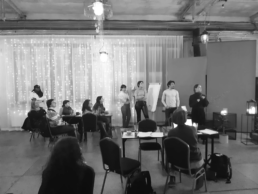
Presenting toolkit in Latvia
Are you convinced about the added value of this toolkit after reading this article? Then don’t hesitate to vote for the toolkit or reach out for us. For enquiries about the toolkit Julie, Britt and Anthony are more than happy to answer your questions. (britt.pellens@hotmail.com, Julie.Amy@hotmail.be, Anthony-chalfoun@live.com)
Or contact us via LinkedIn:
1 World health organization. (2011). World report on disability (ISBN 978 92 4 068521 5). WHO Press. https://www.who.int/teams/noncommunicable-diseases/sensory-functions-disability-and-rehabilitation/world-report-on-disability
2 WHO. (2011). Global burden of mental disorders and the need for a comprehensive, coordinated response from health and social sectors at the country level: Report by the Secretariat. Accessed on the 13th of April 2022, apps.who.int/gb/ebwha/ pdf_files/EB130/B130_9-en.pdf
3 Mental disorders. (2019, 28 november). WHO. Geraadpleegd op 19 april 2022, van https://www.who.int/news-room/fact-sheets/detail/mental-disorders
4 Robic, A. (2022, 9 May). European disability forum. European Disability Forum. Accessed on the 20th of April 2022, van https://www.edf-feph.org
5 Are you interested in building an inclusive society? (2021, 1 september). University of Latvia. Accessed on the6th of April 2022, van https://www.bvef.lu.lv/en/about-us/news/detail-view/t/67617/
6 Scholtz, M. (z.d.). MindTour. Thomas More. Accessed on the 19th of april 2022, van https://www.thomasmore.be/mindtour
7 Museum Dr Guislain. (z.d.). MindTour. Accessed on the 14th of April 2022, van https://www.museumdrguislain.be/nl/home/search

